Module 3—Effects of Force on Velocity
 Explore
Explore
According to Newton's second law, if an unbalanced force is applied to an object, it will accelerate in the direction of the unbalanced force. The fact that an unbalanced force can act on an object implies that there can be multiple forces acting on a single object all at the same time.
| The unbalanced force is often called the net force because it is the vector sum of all the forces acting on an object. |
|
(1) |
| You will recall that net force can be found by multiplying mass times acceleration. |
|
(2) |
| Combining equations (1) and (2) gives equation (3). This equation can be used to determine the acceleration of an object with multiple (unbalanced) forces acting on it. |
|
(3) |
To correctly apply equation (3), you need to generate a free-body diagram and add the unbalanced forces as vectors in one or two dimensions. To do this, you need to recall two concepts:
- how to draw a free-body diagram
- how to add vectors in one and two dimensions
The net-force problems in this lesson will be limited to one-dimension and two-dimensions, and they will fall into four general categories:
- linear (one dimensional)
- at right angles (two dimensional)
- at various angles (two dimensional)
- on an incline
Following are examples of each type of problem. Use these examples to help you complete the practice problems on the following worksheet.
Example Problem 1: Linear (One Dimensional)
A 5.00-kg box rests on a rough surface where the coefficient of kinetic friction is 0.150. A 35.0-N force [left] is applied to the box, and it begins to accelerate. What is the acceleration of the box just after it begins to move?
Analysis
The normal force is equal in magnitude to the weight (N = W); therefore, there is no unbalanced vertical force, making this a one-dimensional problem. Let the positive direction be toward the right.
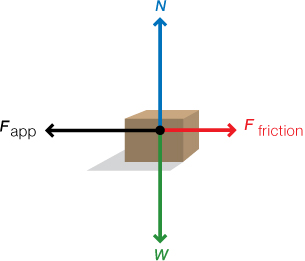
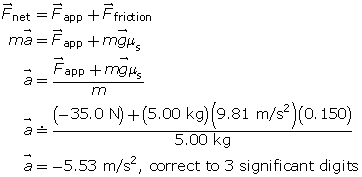
This indicates that the box will accelerate in the same direction as the applied force with a magnitude (correct to 3 significant digits) of 5.53 m/s2. The acceleration of the box just as it begins to move is 5.53 m/s2 [left].
Example Problem 2: At Right Angles (Two Dimensional)
A 10.0-kg box rests on a smooth, frictionless surface. Four ropes are attached to the box, one on each side.
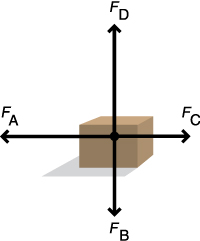
- Rope A applies a 65.0-N force towards the west.
- Rope B applies a 30.0-N force towards the south.
- Rope C applies a 20.0-N force towards the east.
- Rope D applies a 70.0-N force towards the north.
Calculate the acceleration of the box.
Analysis
Let the east direction be the positive x direction and north be the positive y direction. Adding the east-west forces gives the following:

Adding the north-south forces gives the following:

Add the total east-west force to the total north-south force as vectors.
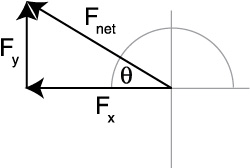
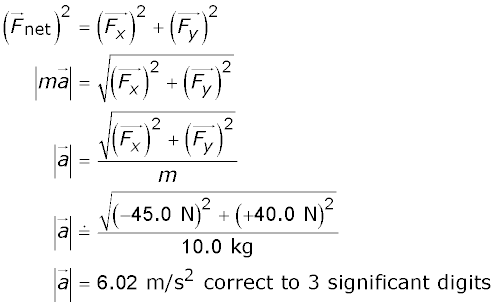
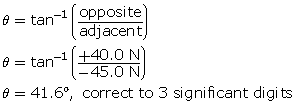
Therefore, the net force and acceleration have the following polar positive direction:
180° – 41.6°= 138.4°
![]() = 6.02 m/s2 at 138° (polar positive), correct to 3 significant digits.
= 6.02 m/s2 at 138° (polar positive), correct to 3 significant digits.
Example Problem 3: At Various Angles (Two Dimensional)
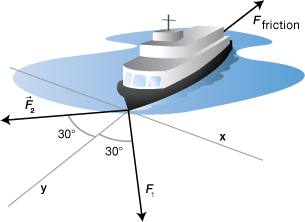
Two tug boats are pulling a larger ship, as illustrated.
 = 3.80 x 105 N
= 3.80 x 105 N = 4.00 x 105 N
= 4.00 x 105 N = 1.00 x 105 N
= 1.00 x 105 N- mass = 5.00 x 106 kg
An x-y coordinate system has been assigned (as illustrated). Calculate the acceleration of the larger ship.
Orient the diagram so that friction acts in the negative y direction.
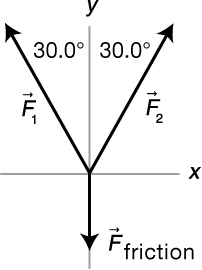
Analysis
Step 1: Resolve ![]() and
and ![]() into x and y components.
into x and y components.
![]() components
components
Recall that F2 = 4.00 × 105 N
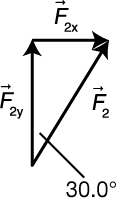
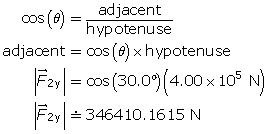
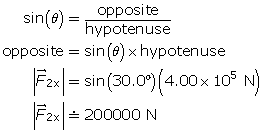
![]() components
components
Recall that F1 = 3.80 × 105 N

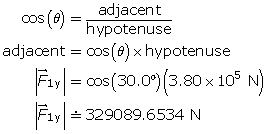
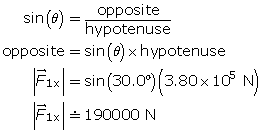
Step 2: Determine the total x and y forces.
Add all of the x forces. 
Add all of the y forces. 
Step 3: Add the x and y components as vectors.
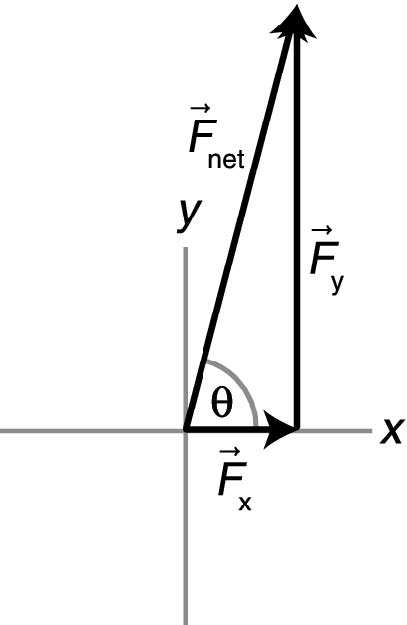
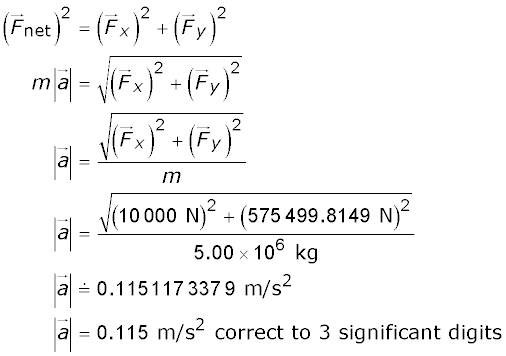
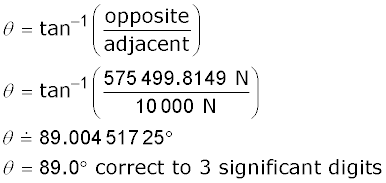
Therefore, the net force and acceleration have the following polar positive direction: 89.0°
![]() = 0.115 m/s2 at 89.0° (polar positive), correct to 3 significant digits
= 0.115 m/s2 at 89.0° (polar positive), correct to 3 significant digits
Example Problem 4: On an Incline
A cross-country cyclist encounters an incline into a river valley that is marked as a 6% grade on the road sign. This corresponds to an angle of 3.4° down from horizontal. If the cyclist and the loaded bike have a combined mass of 95 kg, and the force of friction is initially 40 N, what will be the initial acceleration of the cyclist down the hill?
Given
m = 95 kg Ff = 40 N θ = 3.4°
Required
the acceleration of the cyclist down the hill (![]() )
)
Analysis and Solution
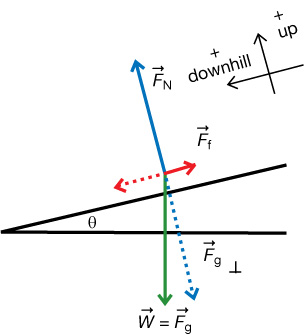

The normal force (![]() ) is equal in magnitude but opposite in direction to
) is equal in magnitude but opposite in direction to ![]() , so there is no acceleration in the up-down direction. These forces can be ignored.
, so there is no acceleration in the up-down direction. These forces can be ignored.
The magnitude of the ![]() can be calculated using the formula
can be calculated using the formula ![]() , as can be seen by resolving the weight into its components in the tip-to-tail vector diagram shown above.
, as can be seen by resolving the weight into its components in the tip-to-tail vector diagram shown above.
In the parallel direction,
![]()
Working only with magnitudes,
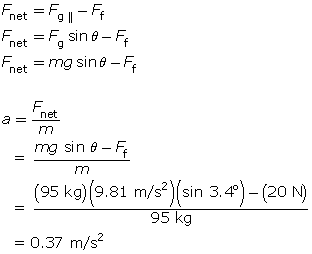
Paraphrase
The cyclist will initially accelerate at 0.37 m/s2 [downhill].
